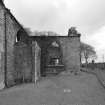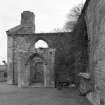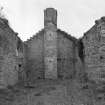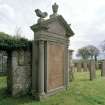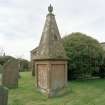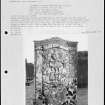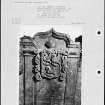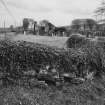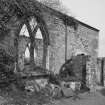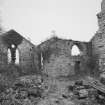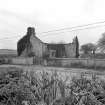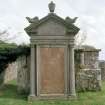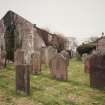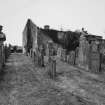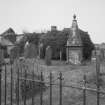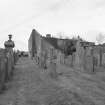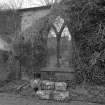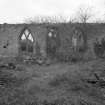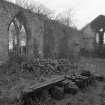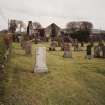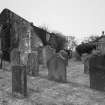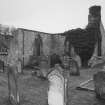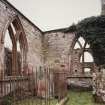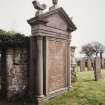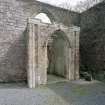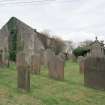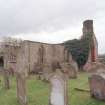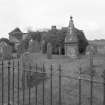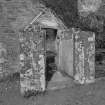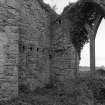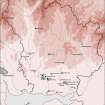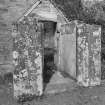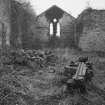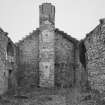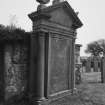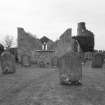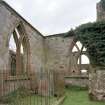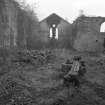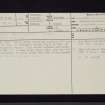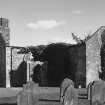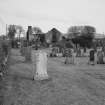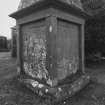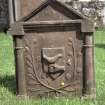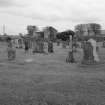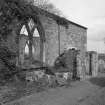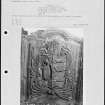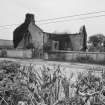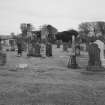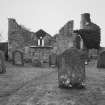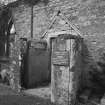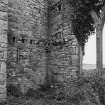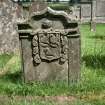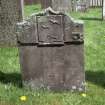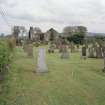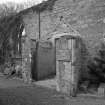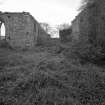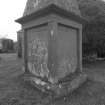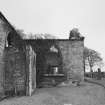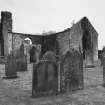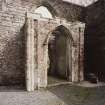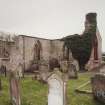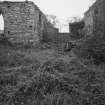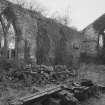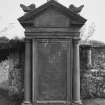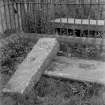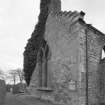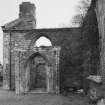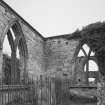Hoddom Parish Church And Churchyard
Burial Ground (19th Century), Church (19th Century)
Site Name Hoddom Parish Church And Churchyard
Classification Burial Ground (19th Century), Church (19th Century)
Alternative Name(s) Hoddomcross Church And Burial-ground; Hoddom, Former Parish Church
Canmore ID 66681
Site Number NY17SE 19
NGR NY 17835 73516
NGR Description NY 17835 73516
Datum OSGB36 - NGR
Permalink http://canmore.org.uk/site/66681
- Council Dumfries And Galloway
- Parish Hoddom
- Former Region Dumfries And Galloway
- Former District Annandale And Eskdale
- Former County Dumfries-shire
Hoddomcross, Dumfriesshire, cross-head fragment
Measurements: H 135mm, W 175mm
Stone type: sandstone
Place of discovery: NY 1783 7351
Present location: built into fabric of ruined parish church of 1817.
Evidence for discovery: found in 1997 by Ian Fisher built into external north wall of church.
Present condition: trimmed for re-use, burnt and worn.
Description
This is the central part of an elaborately ornamented cross-head. It is carved in relief with swirling foliage and rosettes.
Date: ninth or tenth century.
References: RCAHMS 1997, no 1750, 254.
Desk-based information compiled by A Ritchie 2019.
Hoddom 22, Dumfriesshire, cross-shaft fragment
Measurements: H 0.57m +, W 0.20m-0.24m, D 0.14m-0.15m
Stone type:
Place of discovery: NY 1783 7352
Present location: National Museums Scotland, Edinburgh (X.IB.9).
Evidence for discovery: found in the ruins of the Hoddomcross old parish church before or during its demolition in 1817. In a private collection until it was presented to NMAS in 1851.
Present condition: very worn and face C is severely defaced.
Description
This is a substantial portion of a cross-shaft with figural ornament carved in relief. All three surviving figures are robed and in frontal pose, holding books against their chests, and the figure on face B has a marked nimbus framing the head. Each is set within an architectural feature. RCAHMS suggests that it may have belonged to the shaft for the lost cross-head fragment, Hoddom 2 (1997, 254).
Date: eighth century.
References: ECMS pt 3, 439-440; Craig 1992, vol 2, 236-42, vol 4, pl 58; RCAHMS 1997, 254-5.
Desk-based information compiled by A Ritchie 2019.
Hoddom 23, Dumfriesshire, cross-arm fragment
Measurements: H 0.22m, W 0.16m, D 0.12m
Stone type: sandstone
Place of discovery: NY 1783 7352
Present location: National Museums Scotland, Edinburgh (X.IB.51)
Evidence for discovery: found in the ruins of the Hoddomcross old parish church before or during its demolition in 1817. In a private collection until it was presented to NMAS in 1851.
Present condition: very worn and lacking one outer corner.
Description:
This is the outer part of a slightly wedge-shaped cross-arm, carved in relief within flat-band borders. Face A contains a panel of interlace, face B a knot and a spiral, face C some sort of figural motif and the other faces are very worn.
Date: early medieval.
References: ECMS pt 3, 440; Craig 1992, vol 2, 243-5, vol 4, pl 59; RCAHMS 1997, 254-5.
Desk-based information compiled by A Ritchie 2019.
Hoddom 24, Dumfriesshire, cross-head fragments
Measurements: H 0.34m (24a only), W 0.38m. D 0.10m
Stone type: sandstone
Place of discovery: NY 1783 7352
Present location: Dumfries Museum (1951/36/2)
Evidence for discovery: both fragments were recorded lying on top of Hoddom old churchyard wall around 1915, but the smaller fragment appears to have been lost by 1936. The larger fragment was taken to Dumfries Museum in 1951.
Present condition: battered but the carving is clear.
Description:
These two fragments belonged to an elegant cross-head with equal expanded arms, set on a shaft with a double-incised border. On face A within a border of double roll mouldings is interlace carved in relief, which forms a central square within which is a small cross with pellets between its arms. Face C is plain within its double incised outline, apart from a central boss surrounded by two concentric incised circles.
Date: early medieval.
References: Craig 1992, vol 2, 246-8, vol 4, pl 60; RCAHMS 1997, 254-5.
Desk-based information compiled by A Ritchie 2019.
Hoddom 29, Dumfriesshire, cross-base
Measurements: L 1.20m, W 0.85m, D c0.77m
Stone type: sandstone
Place of discovery: NY 1783 7352
Present location: outside the south-east corner of Hoddom churchyard, embedded on its side in the ground.
Evidence for discovery: first recorded in 1897.
Present condition:
Description
The edges of this cross-base are chamfered but otherwise it is plain. The socket for the cross-shaft is 0.49m wide and 0.15m deep, but its length is uncertain.
Date: early medieval.
References: ECMS pt 3, 439-440; Craig 1992, vol 2, 255-6; RCAHMS 1997, 254-5.
Desk-based information compiled by A Ritchie 2019.
Hoddom 25, Dumfriesshire, cross-slab fragment
Measurements: H 0.69m, W 0.40m, D 0.14m
Stone type: sandstone
Place of discovery: NY 1783 7352
Present location: Dumfries Museum (1951/36/3).
Evidence for discovery: found in Hoddom churchyard sometime prior to 1920, and transferred to Dumfries Museum in 1951.
Present condition: worn and the terminals of the cross-arms are damaged.
Description
On a plain shouldered shaft, the cross-head is solid and ringed. The head is carved on both broad faces with deep radial grooves on the arms and a central roundel encircled by a groove.
Date: early medieval.
References: Craig 1992, vol 2, 249-50; RCAHMS 1997, 254-5.
Desk-based information compiled by A Ritchie 2019.
Hoddom 26, Dumfriesshire, carved fragment
Measurements: H0.36m, W 0.22m, D 0.11m
Stone type: sandstone
Place of discovery: NY 1783 7352
Present location: Dumfries Museum (1951/36/4).
Evidence for discovery: found in Hoddom churchyard in 1951 and taken to Dumfries Museum.
Present condition: all edges are broken and the carving is worn.
Description
The fragment is carved on one face with heavy interlace.
Date: early medieval.
References: ECMS pt 3, 439-440; Craig 1992, vol 2, 251; RCAHMS 1997, 254-5.
Desk-based information compiled by A Ritchie 2019.
Hoddom 27, Dumfriesshire, carved fragment
Measurements: H 0.23m, W 0.13m, D 0.13m
Stone type: sandstone
Place of discovery: NY 1783 7352
Present location: Dumfries Museum (1951/36/4).
Evidence for discovery: found in Hoddom churchyard in 1951 and taken to Dumfries Museum.
Present condition: all edges are broken and the carving is worn.
Description
The fragment is carved on one face with heavy interlace.
Date: early medieval.
References: Craig 1992, vol 2, 252; RCAHMS 1997, 254-5.
Desk-based information compiled by A Ritchie 2019.
Hoddom 28, Dumfriesshire, cross fragments
Measurements: 0.70m, W 0.22m, W 0.14m
Stone type: sandstone
Place of discovery: NY 1783 7352
Present location: Dumfries Museum (1951/36/1; 1969/94/1).
Evidence for discovery: first recorded in Hoddom churchyard in 1936 and taken to Dumfries Museum in 1951 (upper fragment) and 1969 (shaft fragment).
Present condition: each fragment is broken top and bottom and weathered.
Description
These two conjoining fragments comprise part of a tapering shaft and the lower arm of its cross-head. Each face is bordered by a cable moulding and inner roll moulding, and otherwise the surface is plain.
Date: early medieval.
References: Craig 1992, vol 2, 253-4; RCAHMS 1997, 254-5.
Desk-based information compiled by A Ritchie 2019.
NY17SE 19.00 17835 73516
Hoddom Church (in ruins)
Graveyard [NAT]
OS (GIS) MasterMap, August 2009.
NY17SE 19.01 1783 7352 Sculptured Stone
NY17SE 19.02 c.178 735 Roman Altar
For old parish churches of Hoddom (NY 1667 7267), Luce (NY 1875 7237) and Ecclefechan (NY 1921 7449), see NY17SE 4.00, NY17SE 6.00, NY17SE 17 respectively.
For monastic enclosure and monastery buildings (NY 166 729 to 169 727), see NY17SE 56.
For successor and present parish church of Hoddom (NY 1925 7454), see NY17SE 67.
The parishes of Hoddam, Ecclefechan and Luce on Annan were united in 1609.
H Scott 1915-61.
(NY 1783 7351) Hoddom parish church was built in 1817 and recast in 1914. It replaced a church, built in 1610, of which fragments remain. (This church replaced that noted on NY17SE 4). A Roman altar stone (NY17SE 19.02), taken from the 17th century building, is built inside the porch of the present church.
G Hay 1957; SDD List 1964
Church burned, altar removed.
Information from A E Truckell, 1978.
Hoddomcross, former Hoddom Parish Church. Roofless since a fire in 1975. T-plan kirk of sneck-harled rubble, designed by the mason-architect John Park in 1816 and built the next year. Hoodmoulded and Y-traceried two-light windows. Pinnacles on the corners of the E and W gables. Another pinnacle on the W gable's apex, but the E gable is topped by a battlemented finial. The gable of the N 'aisle' is crowstepped and carries a tall birdcage bellcote with shallow crenellations. Another shallow battlement on the W side of this 'aisle'. The chunkily-crowstepped porches either side of the S wall look like later additions, perhaps dating from alterations made by Robert Douglas in 1913-14. The interior contained galleries and, in the aisle, a retiring room for the Sharpes of Hoddom.
In the graveyard, three burial-enclosures, probably all Georgian, but the one immediately SW of the church (containing a memorail tablet to the Rev. Alexander Orr, died 1767) has stumpy attached columns corbelled out along the W and S sides. Also built into the W side, a purposeless console. On the outer face of this enclosure's W wall, a large urn-finialled Roman Doric aedicular monument with foliaged scrolls at the sides; it was erected in 1779 by James Clow to commemmorate his wife, Mary Hunter, of whom the inscription relates: 'And to be short to her Praise she was the wife that Solomon speaks of in the XXXI Chap of the book of Prov. from the 10th verse to the End'. SE of the church, an urn-finialled obelisk on a big predestal; a monument to John Jeffrey, died 1799. Good number of 18th century headstones carved with coats of arms and emblems of death.
J Gifford 1996.
Roofless shell of T-plan gothic church by John Park, mason, 1817; enclosed by churchyard. CHURCH: rubble-built with stugged and graded pink quoins; polished red ashlar roll-mouldings, hoodmoulds, Y-tracery and spiky pinnacles. 3 porches (main porch in re-entrant angle; crow-stepped porches on long S wall), none, perhaps, original. Jamb also crow-stepped and with tall (formerly louvred) birdcage belfry.
Notice at site states that church was burned out on night of 2-3 February 1975. Present parish of Hoddom formed 1609 with this site chosen for church. (Historic Scotland)
Reference (1997)
NY17SE 19.00 1783 7351
Listed as Hoddomcross, church and burial-ground. Carved stones found here, but probably from Hoddom, include: Anglian cross-shaft and fragment (NMS IB 9, IB 51); sculptured stone; and runic inscription (lost).
RCAHMS 1997.
Reference (1997)
NY 1783 7351 NY17SE 19.00
Hoddomcross church. Listed as inscriptions. Probably from Birrens.
RCAHMS 1997.



























































































